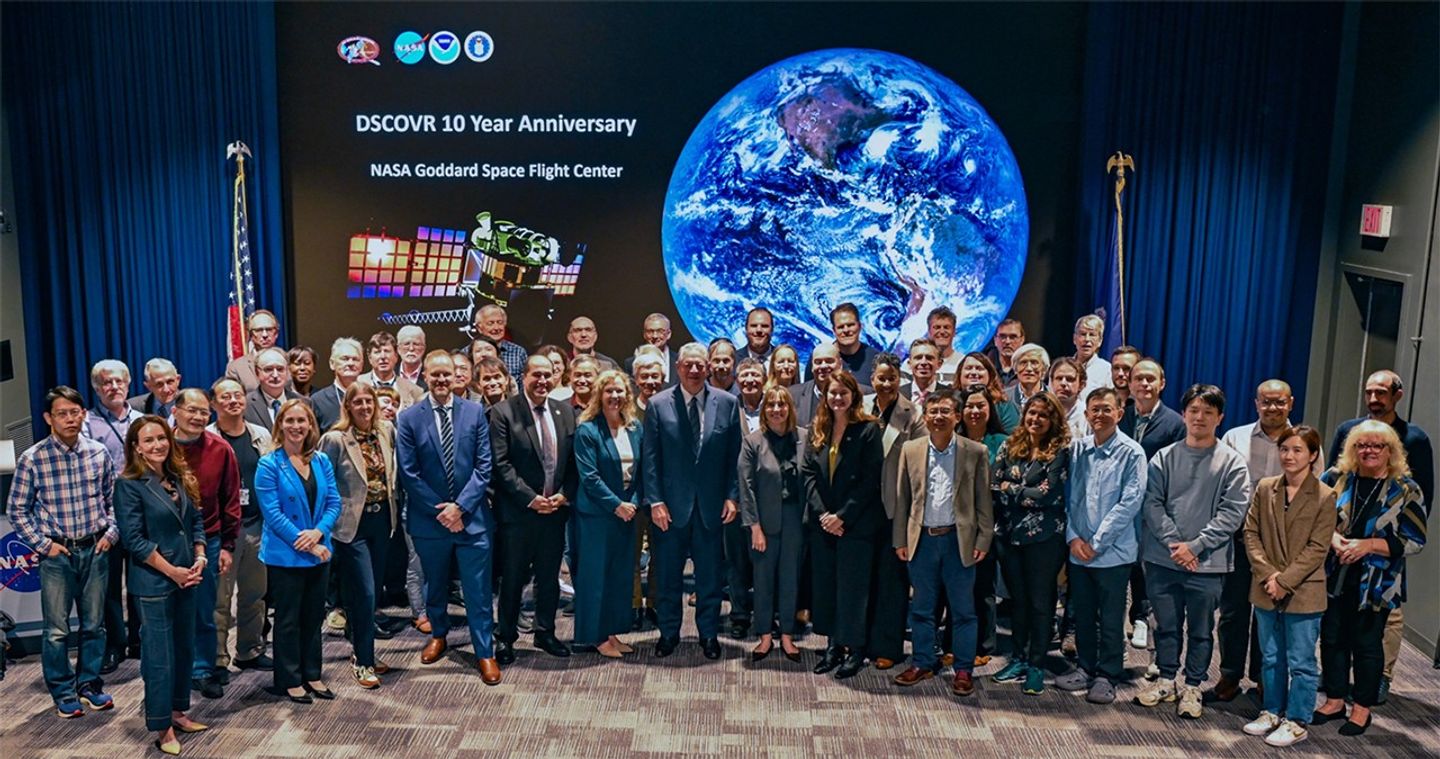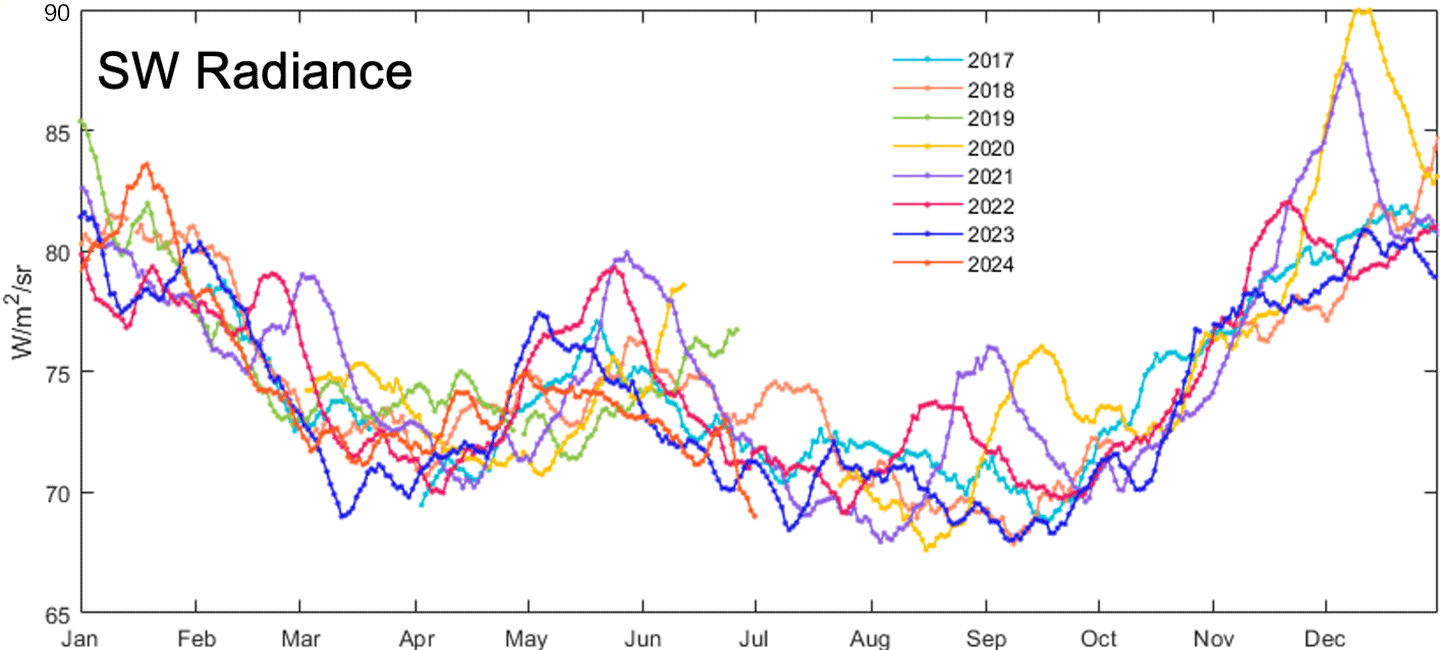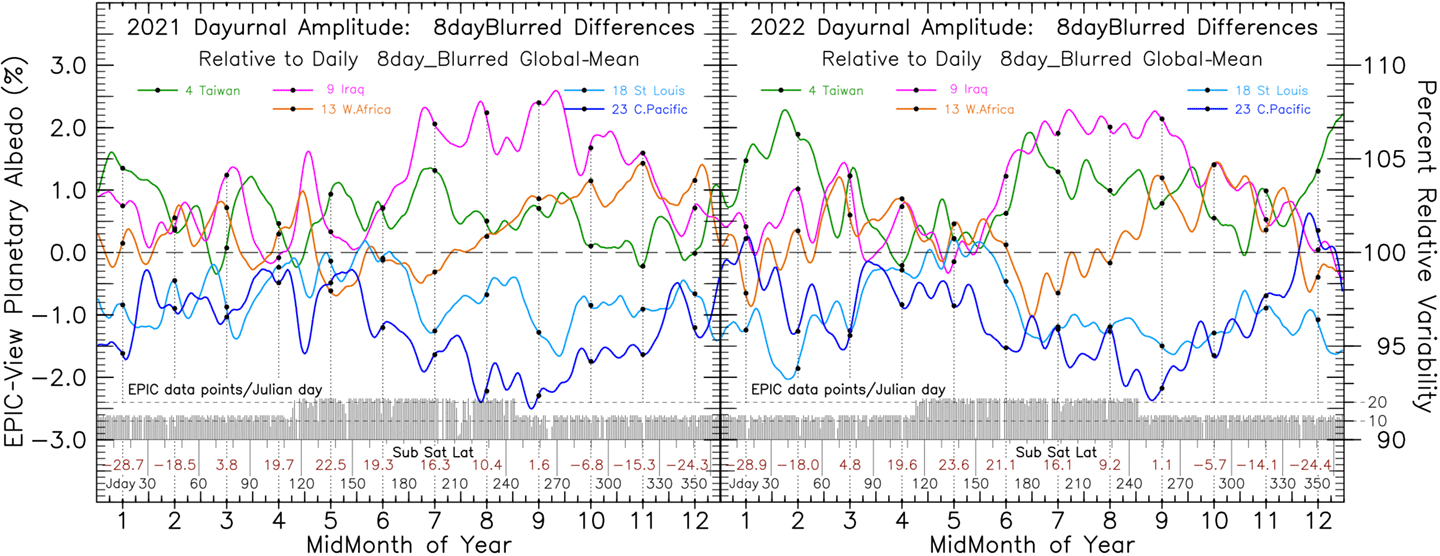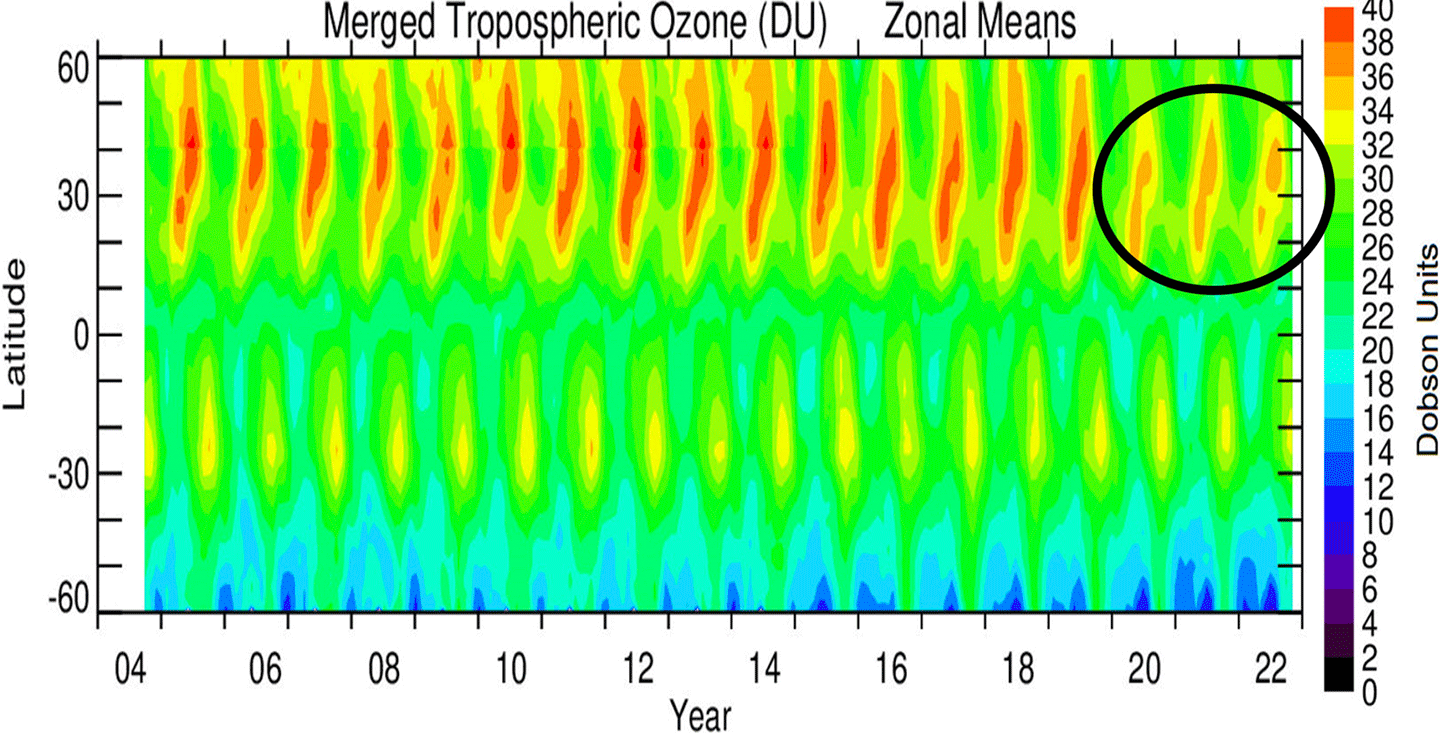
21 min read
Introduction
The 10th Deep Space Climate Observatory (DSCOVR) Earth Polychromatic Camera (EPIC) and National Institute of Standards and Technology (NIST) Advanced Radiometer [NISTAR] Science Team Meeting (STM) was held October 16-18, 2024. Over 50 scientists attended, most of whom were from NASA's Goddard Space Flight Center (GSFC), with several participating from other NASA centers, U.S. universities, and U.S. Department of Energy laboratories. There was one international participant - from Estonia. A full overview of DSCOVR's Earth-observing instruments was published in a previous article in The Earth Observer and will not be repeated here. This article provides the highlights of the 2024 meeting. The meeting agenda and full presentations can be downloaded from GSFC's Aura Validation Data Center.
Opening Presentations
The opening session of the 10th DSCOVR STM was special. Former U.S., Vice President Al Gore attended the opening session and gave a presentation at the panel discussion "Remote Sensing and the Future of Earth Observations" - see Photo. Gore was involved in the early days of planning the DSCOVR mission, which at that time was known as Triana. He reminisced about his involvement and praised the team for the work they've done over the past decade to launch and maintain the DSCOVR mission. Following the STM Opening Session, Gore spoke at a GSFC Engage session in Building 3 later that afternoon on the same topic, but before a wider audience. [Link forthcoming.]
Following Gore's remarks, the remainder of the opening session consisted of a series of presentations from DSCOVR mission leaders and representatives from GSFC and National Oceanic and Atmospheric Administration (NOAA). Thomas Neumann [GSFC, Earth Sciences Division (ESD)-Deputy Director] opened the meeting and welcomed Vice President Gore and the STM participants on behalf of the ESD. Adam Szabo [GSFC-DSCOVR Project Scientist] briefly reported that the spacecraft was still in "good health." The EPIC and NISTAR instruments on DSCOVR continue to return their full science observations. He also gave an update on DSCOVR Space Weather research. Alexander Marshak [GSFC-DSCOVR Deputy Project Scientist] briefly described DSCOVR mission history and the science results based on DSCOVR observations from the first Sun-Earth Lagrange point (hereinafter, the L1 point). He also summarized the major EPIC and NISTAR results to date. At this time, more than 125 papers related to DSCOVR are listed on the EPIC website. Elsayed Talaat [NOAA, Office of Space Weather observations-Director] discussed the future of Earth and space science studies from the L1 point.

Updates on DSCOVR Operations
The DSCOVR mission components continue to function nominally. The meeting was an opportunity to update participants on progress over the past year on several fronts, including data acquisition, processing, and archiving, and release of new versions of several data products. The number of people using DSCOVR data continues to increase, with a new Science Outreach Team having been put in place to aid users in several aspects of data discovery, access, and user friendliness.
Amanda Raab [NOAA, DSCOVR Mission Operations and Systems] reported on the current status of the DSCOVR mission. She also discussed spacecraft risks and issues such as memory fragmentation and data storage task anomalies but indicated that both these issues have been resolved.
Hazem Mahmoud [NASA's Langley Research Center (LaRC)] discussed the work of the Atmospheric Science Data Center (ASDC), which is based at LaRC. He showed DSCOVR mission metrics since 2015, focusing on data downloads and the global outreach of the mission. He noted that there has been a significant rise in the number of downloads and an increasing diversity of countries accessing ozone (O3), aerosol, and cloud data products. Mahmoud also announced that the ASDC is transitioning to the Amazon Web Services cloud, which will further enhance global access and streamline DSCOVR data processing.
Karin Blank [GSFC] covered the discovery of a new type of mirage that can only be seen in deep space from EPIC. The discussion included the use of a ray tracer in determining the origin of the phenomenon, and under what conditions it can be seen.
Alexander Cede [SciGlob] and Ragi Rajagopalan [LiftBlick OG] gave an overview of the stability of the EPIC Level-1A (L1A) data over the first decade of operation. They explained that the only observable changes in the EPIC calibration are to the dark count and flat field can - and that these changes can be entirely attributed to the temperature change of the system in orbit compared to prelaunch conditions. No additional hot or warm pixels have emerged since launch and no significant sensitivity drifts have been observed. The results that Cede and Rajagopalan showed that EPIC continues to be a remarkably stable instrument, which is attributed to a large extent to its orbit around the L1 point, which is located outside the Earth's radiation belts and thus an extremely stable temperature environment. Consequently, in terms of stability, the L1 point is far superior to other Earth observation points, e.g., ground-based, low-Earth orbit (LEO), polar orbit, or geostationary Earth orbit (GEO).
Marshall Sutton [GSFC] discussed the state of the DSCOVR Science Operation Center (DSOC). He also talked about processing EPIC Level-1 (L1) data into L2 science products, daily images available on the EPIC website, and special imaging opportunities, e.g., volcanic eruptions.
EPIC Calibration
After 10 years of operation in space, the EPIC instrument on DSCOVR continues to be a remarkably stable instrument. The three presentations describe different ways that are used to verify the EPIC measurements remain reliable.
Conor Haney [LaRC] reported on anomalous outliers during February and March 2023 from the broadband shortwave (SW) flux using EPIC L1B channel radiances. To ensure that these outliers were not a result of fluctuations in the EPIC L1B channel radiances, both the EPIC radiance measurements and coincident, ray-matched radiance measurements from the Visible Infrared Imaging Radiometer Suite (VIIRS), on the Suomi National Polar-orbiting Partnership (Suomi NPP) platform, were processed using the same deep convective cloud invariant target (DCC-IT) algorithm. This analysis confirmed that the anomalous behavior was due to the DCC-IT algorithm - and not because of fluctuations in the EPIC L1B channel radiances. The improved DCC-IT methodology was also applied to the EPIC L1B radiances. The results indicate that the EPIC record is quite stable with a lower uncertainty than when processed using the previous DCC-IT methodology.
Igor Geogdzhaev [NASA's Goddard Institute for Space Studies (GISS)/Columbia University] reported that EPIC Visible-Near Infrared (VIS-NIR) calibration based on VIIRS (on Suomi NPP) data has showed excellent stability, while VIIRS (on NOAA-20 and -21) derived gains agree to within 1-2%. Preliminary analysis showed continuity in the gains derived from Advanced Baseline Imager (ABI) data. (ABI flies on NOAA's two operational Geostationary Operational Environmental Satellite-Series R satellites - GOES-17 and GOES-18.
Liang-Kang Huang [Science Systems and Applications, Inc. (SSAI)] reported on updates to the EPIC ultraviolet (UV) channel sensitivity time dependences using Sun-normalized radiance comparisons between EPIC and measurements from the Ozone Mapping and Profiler Suite (OMPS) Nadir Mapper (NM) on Suomi NPP, with coinciding footprints and solar/satellite angles. Huang's team determined vignetting factors in the sensitivity calibration between 2021-2024, as a function of charge coupled device (CCD) pixel radius and pixel polar angles, using special lunar measurement sequences.
NISTAR Status and Science with Its Observations
The NISTAR instrument remains fully functional and continues its uninterrupted data record. The NISTAR-related presentations during this meeting included more details on specific topics related to NISTAR as well as on efforts to combine information from both EPIC and NISTAR.
Steven Lorentz [L-1 Standards and Technology, Inc.] reported that the NISTAR on DSCOVR has been measuring the irradiance from the sunlit Earth in three bands for more than nine years. The three bands measure the outgoing total and reflected-solar radiation from Earth at a limited range of solar angles. To compare the long-term stability of EPIC and NISTAR responses, researchers developed a narrowband to wideband conversion model to allow the direct comparison of the EPIC multiband imagery and NISTAR SW - see Figure 1 - and silicon photodiode channels. Lorentz presented daily results spanning several years. The comparison employed different detectors from the same spacecraft - but with the same vantage point - thereby avoiding any model dependent orbital artifacts.

Clark Weaver [University of Maryland, College Park (UMD)] used spectral information from the SCanning Imaging Absorption spectroMeter for Atmospheric CartograpHY (SCIAMACHY), which flew on the European Space Agency's (ESA) Envisat satellite from 2002-2012, to fill EPIC spectral gaps. He reported on construction of a composite height resolution spectrum that was spectrally integrated to produce SW energy. Weaver explained that he compared the EPIC reflected SW with four-hour averages from Band 4 on NISTAR. He used spectral information from SCIAMACHY to fill in gaps. Weaver also discussed results of a comparison of area integrated EPIC SW energy with observations from NISTAR .
Andrew Lacis [GISS] reported on results of analysis of seven years of EPIC-derived planetary albedo for Earth, which reveal global-scale longitudinal variability occurring over a wide range of frequencies - with strong correlation between nearby longitudes and strong anticorrelation between diametrically opposed longitudes. This behavior in the Earth's global-scale energy budget variability is fully corroborated by seven years of NISTAR silicon photodiode measurements, which view the Earth with 1º longitudinal resolution. This analysis establishes the DSCOVR mission EPIC/NISTAR measurements as a new and unmatched observational data source for evaluating global climate model performance- e.g., see Figure 2.

Wenying Su [LaRC] discussed global daytime mean SW fluxes within the EPIC field of view produced from January 2016-June 2024. These quasi-hourly SW fluxes agree very well with the Synoptic data product from the Clouds and the Earth's Radiant Energy System (CERES) instruments (currently flying on the Terra and Aqua, Suomi NPP, and NOAA-20 platforms) with the root mean square errors (rmse) less than 3 W/m2. This SW flux processing framework will be used to calculate NISTAR SW flux when Version 4 (V4) of the NISTAR radiance becomes available. Su noted that SW fluxes from EPIC are not suitable to study interannual variability as the magnitude of EPIC flux is sensitive to the percentage of daytime area visible to EPIC.
Update on EPIC Products and Science Results
EPIC has a suite of data products available. The following subsections summarize content during the DSCOVR STM related to these products. The updates focus on several data products and the related algorithm improvements.
Total Column Ozone
Jerry Ziemke [Morgan State University (MSU), Goddard Earth Sciences Technology and Research-II (GESTAR II)] and Natalya Kramarova [GSFC] reported that tropospheric O3 from DSCOVR EPIC shows anomalous reductions of ~10% throughout the Northern Hemisphere (NH) starting in Spring 2020 that continues to the present. The EPIC data, along with other satellite-based (e.g., Ozone Monitoring Instrument (OMI) on NASA's Aura platform) and ground-based (e.g., Pandora) data, indicate that the observed NH reductions in O3 are due to combined effects from meteorology and reduced pollution, including reduced shipping pollution in early 2020 (during COVID) - see Figure 3. EPIC 1-2 hourly data are also used to evaluate hourly total O3 and derived tropospheric O3 from NASA's Tropospheric Emissions: Monitoring of Pollution (TEMPO) geostationary instrument. Ziemke explained that comparison of TEMPO data with EPIC data has helped the researchers characterize a persistent latitude-dependent offset in TEMPO total O3 data of ~10-15% from south to north over the North American continent.

Algorithm Improvement for Ozone and Sulfur Dioxide Products
Kai Yang [UMD] presented a comprehensive evaluation of total and tropospheric O3 retrievals, highlighting the long-term stability and high accuracy of EPIC measurements. He also validated EPIC's volcanic sulfur dioxide (SO2) retrievals by comparing them with ground-based Brewer spectrophotometer measurements and summarized EPIC's observations of SO2 from recent volcanic eruptions.
Simon Carn [University of Michigan] showed the first comparisons between the EPIC L2 volcanic SO2 product and SO2 retrievals from the Geostationary Environment Monitoring Spectrometer (GEMS) on the Korean GEO-Kompsat-2B satellite. GEMS observes East Asia as part of the new geostationary UV air quality (GEO-AQ) satellite constellation (which also includes TEMPO that observes North America and will include the Ultraviolet-Visible-Near Infrared (UVN) instrument on the European Copernicus Sentinel-4 mission, that will be launched in 2025 to observe Europe and surrounding areas) - but is not optimized for measurements of high SO2 columns during volcanic eruptions. EPIC SO2 data for the 2024 eruption of Ruang volcano in Indonesia are being used to validate a new GEMS volcanic SO2 product. Initial comparisons show good agreement between EPIC and GEMS before volcanic cloud dispersal and confirm the greater sensitivity of the hyperspectral GEMS instrument to low SO2 column amounts.
Aerosols
Alexei Lyapustin [GSFC] reported that the latest EPIC aerosols algorithm (V3) simultaneously retrieves aerosol optical depth, aerosol spectral absorption, and aerosol layer height (ALH) - achieving high accuracy. He showed that global validation of the single scattering albedo in the blue and red shows 66% and 81-95% agreement respectively, with Aerosol Robotic Network (AERONET) observations - which is within the expected error of 0.03 for smoke and dust aerosols. Lyapustin also reported on a comparison of EPIC aerosol data collected from 2015-2023 by the Cloud-Aerosol Lidar with Orthogonal Polarization (CALIOP), which flew on the Cloud-Aerosol Lidar and Infrared Pathfinder Satellite Observations (CALIPSO) mission. The results show that ALH is retrieved with rmse ~1.1 km (0.7 mi). ALH is unbiased over the ocean and is underestimated by 450 m (1470 ft) for the smoke and by 750 m (2460 ft) for the dust aerosols over land.
Myungje Choi and Sujung Go [both from University of Maryland, Baltimore County's (UMBC), GESTAR II] presented results from a global smoke and dust characterization using Multi-Angle Implementation of Atmospheric Correction (MAIAC) algorithm. This study characterized smoke and dust aerosol properties derived from MAIAC EPIC processing, examining spectral absorption, ALH, and chemical composition (e.g., black and brown carbon). Regions with smoldering wildfires, e.g., North America and Siberia, exhibited high ALH and a significant fraction of brown carbon, while Central Africa showed lower ALH with higher black carbon emissions.
Omar Torres [GSFC] discussed how L1 DSCOVR-EPIC observations are being used to study air quality (i.e., tropospheric O3 and aerosols) globally. Torres noted that this application of EPIC-L1 observations is of particular interest in the Southern Hemisphere (SH) where, unlike over the NH, there are currently no space GEO-based air quality measurements - and no plans for them in the foreseeable future.
Hiren Jethva [MSU, GESTAR II] presented the new results of the aerosol optical centroid height retrieved from the EPIC Oxygen-B band observations. He described the algorithm details, showed retrieval maps, and reviewed the comparative analysis against CALIOP backscatter-weighted measurements. The analysis showed a good level of agreement with more than 70% of matchup data within 1-1.5 km (0.6-0.9 mi) difference.
Jun Wang [University of Iowa] presented his team's work on advancing the second generation of the aerosol optical centroid height (AOCH) algorithm for EPIC. Key advancements included: constraining surface reflectance in aerosol retrieval using an EPIC-based climatology of surface reflectance ratios between 442-680 nm; incorporating a dynamic aerosol model to characterize aged smoke particles; and employing a spectral slope technique to distinguish thick smoke plumes from clouds. Results show that both atmospheric optical depth (AOD) and AOCH retrievals are improved in the second generation of AOCH algorithm.
Olga Kalashnikova [NASA/Jet Propulsion Laboratory (JPL)] reported on improving brown carbon evolution processes in the Weather Research and Forecasting model coupled with Chemistry






